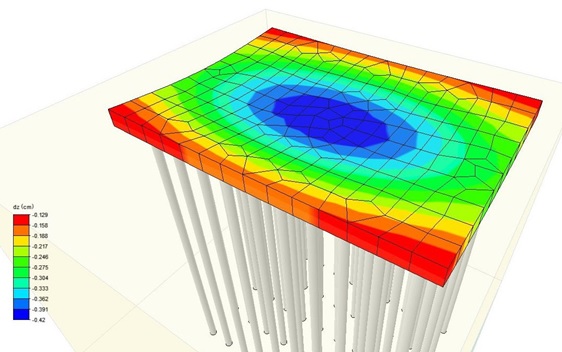Numerical Analysis of Piled Raft Foundations in Alluvial soil

DOI:
https://doi.org/10.54060/jmce.v3i2.25Abstract
In this age of rapid urbanization, population is rapidly increasing in urban area, therefore a new concept of vertical cities has been introduced in form of high-rise building, and there are many conventional methods for design of foundation systems for high rise buildings. In most of the conventional methods pile foundations have been given preference for high rise buildings, all the loads of the building are transferred to the soil by piles. Some of the pressure of the building can also be transfer by raft directly to the soil by contact pressure which is neglected in most of the conventional designs of pile raft foundation system. But from last decades, optimised way of designing of pile raft foundation system have been started by engineers, in which raft foundation is allowed to transfer some of the total load directly to the ground by contact pressure. This optimised way of designing has made the foundation system more economical and sustainable. This type of foundation system in which some part of the load is transfer by raft and some by piles are called as pile raft foundation system. Soil – structure interaction in this pile raft foundation system is very complex in nature and to study this soil – structure interaction we need some numerical techniques or numerical methods. So, in this paper, we are going to use one of the numerical methods for numerical analysis of pile raft foundation system. There are various factors that influence the behaviour of pile raft foundation, some of the important factor that we are going to see in this paper are raft thickness, pile length, pile spacing and number of piles. All these factors are very important for optimize and economical design of pile raft foundation system. In this paper, numerical analysis has been done by using finite element software that is GEOTECH 3D Foundation to find out the influence of above factors on pile raft foundation system in alluvial soil.
Downloads
References
J. Bowles, “Foundation Analysis and Design,” McGraw-Hill Inc. United States of America, vol.1004, pp.1-807, 1997.
J. Burland, “Piles as Settlement Reducers,” Keynote Address 18th Italian Congress on Soil Mechanics Pavia Italy, pp.2727-2730, 1995.
Y. K. Chow & C. I. Teh, “Pile-Cap-Pile-Group Interaction in Nonhomogeneous Soil,” Journal of Geotechnical Engineering, vol. 117, no.11, pp.1655-1667, 1991.
J. A. Hooper, “Observations on the Behaviour of a Piled-Raft Foundation on London Clay,” Proceedings of Institution of Civil Engineers, vol.55, no.2, pp.855-877, 1973.
R. Katzenbach & O. Reul, “Design and Performance of Piled Rafts,” Proceedings of 14th International Conference on Soil Me-chanics and Foundation Engineering, Hamburg, vol. 4, pp.2253-2256, 1997.
W. Liu & M. Novak, “Soil Pile Cap Static Interaction Analysis by Finite and Infinite Elements,” Canadian Geotechnical Journal, vol.28, pp.771– 783, 1991.
D. K. Maharaj, “Load-Settlement Behaviour of Piled Raft Foundation by Three-Dimensional Nonlinear Finite Element Analysis,” Electronic Journal of Geotechnical Engineering, vol.8, 2003.
M. Ottaviani, “Three-dimensional Finite Element Analysis of Vertically Loaded Pile Groups,” Geotechnique, vol.25, no.2, pp.159-174, 1975.
H. G. Poulos, “Analysis of Piled Strip Foundations,” Computer Methods & Advances in Geomechanics Balkema Rotterdam, vol.1, pp.183-191, 1991.
H. G. Poulos & E. H. Davis, “Pile Foundation Analysis and Design,” John Wiley and Sons New York, pp.1-389, 1980.
M. F. Randolph & P. Clancy, “Analysis and Design of Piled raft Foundations,” International Journal for Numerical and Analytical Methods in Geomechanics, vol.10, pp.59-72, 1993.
M. F. Randolph & C. P. Wroth, “An Analysis of the Vertical Deformation of Pile Groups,” Geotechnique, vol.29, no.4, pp.423-429, 1979.
G. H. Poulos, “The Design of High-Rise Building Foundations Coffey Geotechnics,” Sydney Australia Geotec Hanoi October, ISBN 978-604-82-000-8-2011, vol.10, 2016.
IS CODE 16700:2017, “Criteria for structural safety of tall concrete buildings”
M. M. Ali “Tall Buildings and Urban Habitat of the 21st Century: A Global Perspective Buildings,” vol.2, pp.384-423, 2012.
D. Trabucco & A. Wood, “Manuscript LCA of Tall Buildings: Still a Long Way to Go,” Journal of Building Engineering, vol.7, no.3, 2016.
IS: 2720 “Method of test for soils, Part XII, Determination of shear strength parameters of soil from consolidated undrained triaxial test with measurement of pore water pressure” first version, 1981.
L. S. Beedle, M. M. Ali, P. J. Armstrong, et al., “The Skyscraper and the City: Design, Technology, and Innovation, Books Lewiston NY, “The Edwin Mellen Press, vol.13, no.14, pp.1-448, 2007.
F. Sluis, F. Besseling, P. Stuurwold, et al., “Validation and Application of the Embedded Pile Row Feature in PLAXIS 2D,” Plaxis Bulletin Autumn Issue, pp.10-13, 2013.

Downloads
Published
How to Cite
CITATION COUNT
Issue
Section
License
Copyright (c) 2023 Devesh Ojha, Rajendra Kumar Srivastava

This work is licensed under a Creative Commons Attribution 4.0 International License.
























